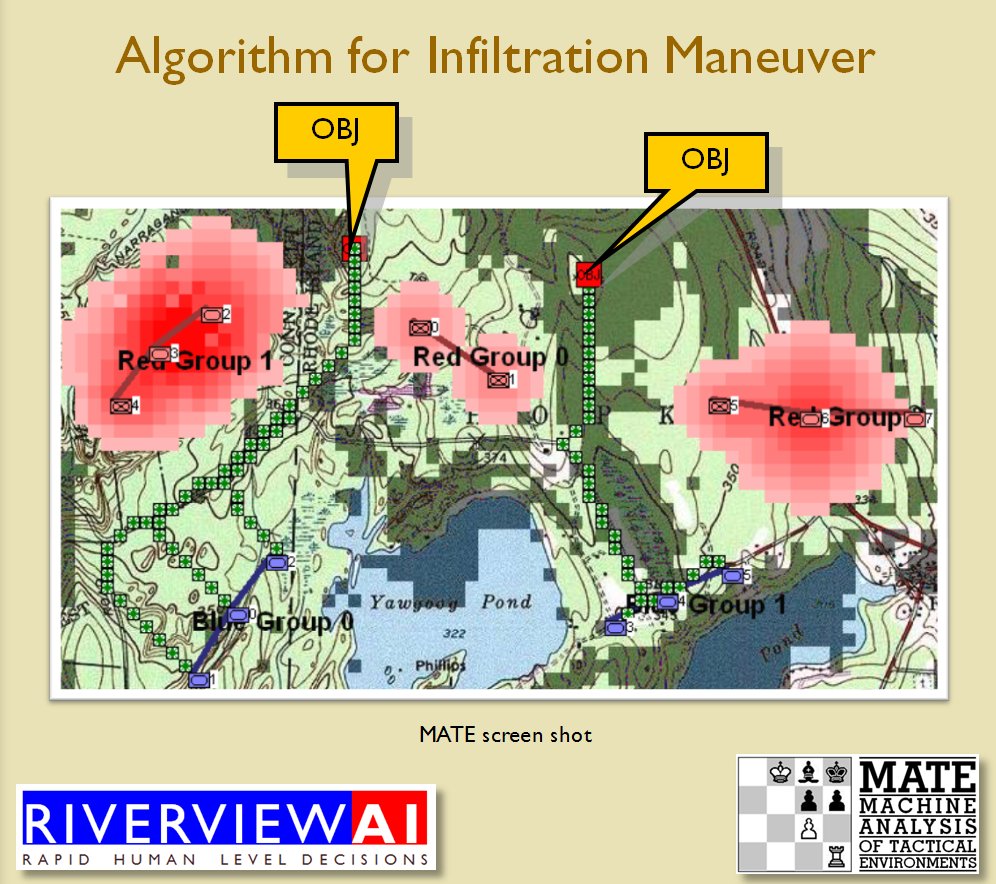In my two previous blog posts on the subject of battlefield analysis (computational military reasoning and tactical artificial intelligence) I discussed how the TIGER1)Tactical Inference Generator / MATE2)Machine Analysis of Tactical Environments program can identify certain key tactical positions such as anchored / unanchored flanks and restricted / unrestricted avenues of approach (attack) and retreat. In this blog post we will look at how TIGER / MATE performs analysis of frontages and implements the infiltration and penetration maneuvers.
 MATE / TIGER employs a number of ‘building block’ algorithms that are used in various tactical and battlefield analysis algorithms. One set of building block algorithms are the Grouping algorithms that determine weaknesses in frontages. The following slides are from an unclassified briefing that I gave to DARPA (the Defense Advanced Research Project Agency) on my MATE program (funded by DARPA research grant W911NF-11-200024):
MATE / TIGER employs a number of ‘building block’ algorithms that are used in various tactical and battlefield analysis algorithms. One set of building block algorithms are the Grouping algorithms that determine weaknesses in frontages. The following slides are from an unclassified briefing that I gave to DARPA (the Defense Advanced Research Project Agency) on my MATE program (funded by DARPA research grant W911NF-11-200024):
All slides can be enlarged by clicking on them. Note: OPFOR = Opposition Forces. In all of these slides OPFOR are the red units.


 With the above building block algorithms we can calculate the optimum part of OPFOR’s frontage to set as the Schwerpunkt. Schwerpunkt is a German word meaning, “the point of maximum effort.” The term was used in blitzkrieg planning to specify, “the center of gravity, point of main effort, where a decisive result was to be achieved.”
With the above building block algorithms we can calculate the optimum part of OPFOR’s frontage to set as the Schwerpunkt. Schwerpunkt is a German word meaning, “the point of maximum effort.” The term was used in blitzkrieg planning to specify, “the center of gravity, point of main effort, where a decisive result was to be achieved.”
![]() Using the above algorithms we can now calculate the Schwerpunkt for implementing the penetration and infiltration maneuvers. The following slides are from an unclassified briefing that I gave to DARPA (the Defense Advanced Research Project Agency) on my MATE program (funded by DARPA research grant W911NF-11-200024): All slides can be enlarged by clicking on them.
Using the above algorithms we can now calculate the Schwerpunkt for implementing the penetration and infiltration maneuvers. The following slides are from an unclassified briefing that I gave to DARPA (the Defense Advanced Research Project Agency) on my MATE program (funded by DARPA research grant W911NF-11-200024): All slides can be enlarged by clicking on them.







 The Five Canonical Offensive Maneuvers are from the U. S. Army Field Manual 3-21 which is available online. As always, if you have any questions please feel free to email me.
The Five Canonical Offensive Maneuvers are from the U. S. Army Field Manual 3-21 which is available online. As always, if you have any questions please feel free to email me.



